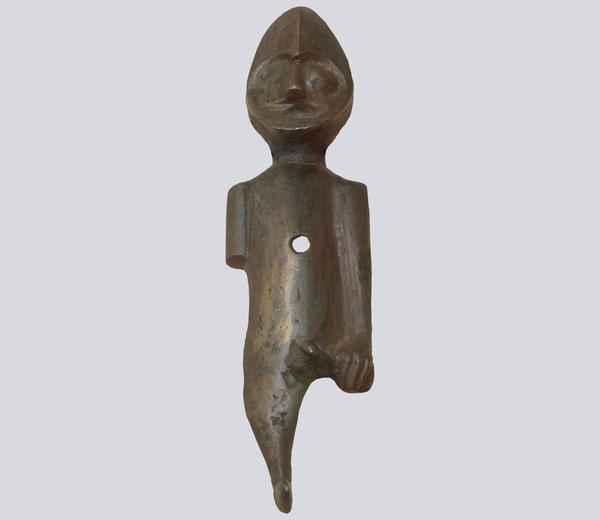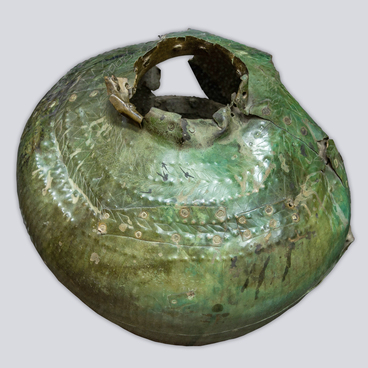Over the history of archaeological excavations in Volga Bulgaria, only eight idols like that or fragments thereof have been found. This particular item was discovered on the Bilyar settlement site in the 1870’s.
1 / 2
Idol
Время создания
11th-13th centuries
Размер
14.3х3.8х1.5 cm
Техника
bronze, casting
Выставка
0
Открыть в приложении#1
Idol
#4
#5
A medieval craftsman cast this single-sided anthropomorphous figure of goldish bronze, using a wax model. The proportions leave much to be desired: the figure’s head is too big, the neck is short, and the leg dystrophic. Also, the idol lacks one eye, one leg, and a fragment of the right hand. The left hand stretches along the nude body and ends with a strongly clenched fist with five fingers at the hip. The author emphasized the sign of masculinity in the figure.
#6
The idol’s head resembles a drop with a couple of facets. Researchers think that this kind of shape was designed by the craftsman to illustrate the headdress or a high hair style. The idol’s face is concave, the nose and chin sharpened and elongated. The mouth is rounded, so the figure seems to be shouting or singing.
#7
The meaning of the artifact to Central Trans-Kama people is not known for sure. According to one interpretation, that was a totem of the pagan cult of fertility, because the privy parts of the idol are depicted rather in detail, unlike the other parts of the body. Another version is that the figure symbolized a wish for a new life without health problems. Still another option not excluded by experts is that the idol could stand for a tribal ancestor or a mystic creature
#8
However, specialists share the feeling that the bronze idol was part or a component of a bigger article. Similar figures would serve as sort of pendants for check-locks. Some of them were made in animalistic or zoomorphic style, such as in the form of a horse or ram.
#9
Historians believe that Volga Bulgarians used locks with keys for decorative and ritual purposes, to decorate chests with valuable items or hang them on entry doors for protection against evil forces.
#2
Artifacts like this prove that Volga Bulgaria was inhabited by peoples and ethnic groups of diverse beliefs, both pagan and Islamic. Experts note that Bulgarian society did not have discrimination or confrontation based on ethnicity or religion.
#10
National Museum of the Republic of Tatarstan
читать дальшескрыть
00:00
00:00
1x
Idol
Время создания
11th-13th centuries
Размер
14.3х3.8х1.5 cm
Техника
bronze, casting
Выставка
0
Открыть в приложении
Поделиться



